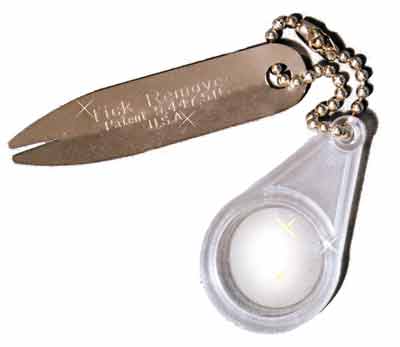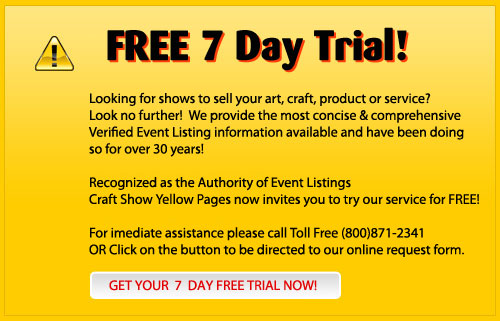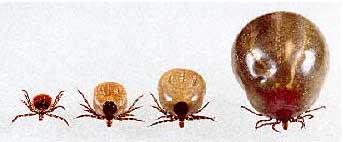|
















Craft Show
Yellow Pages
©
Toll Free:
(800) 871-2341
Tel: (562) 869-5882
Fax: (562) 904-0546
Office Hours:
M-F 10am-8pm EST |

|

~ Removes Ticks
more Effectively than Tweezers ~
Please NOTE: The information found on this page
regarding commercial tick removal tools is provided for your viewing and
informational purposes only, we are not the sellers of any of these tools but
thank the individuals named for their effort in providing this information. To
assist you find these tick removal tools please follow the links below. Art and
Craft Show Yellow Pages offers event listings that contain in-depth details and
information to help you choose the right shows to sell your arts and crafts,
promotional items, food vending, trade or wholesale. To find out more about our
service CLICK HERE!
see pricing information and
click
here to order online.
To find out more go to Amazon

The above product might
have changed from image but search the web for other models.
|
Evaluation of Three
Commercial Tick Removal Tools
|
by:
Richard L. Stewart Jr, Willy Burgdorfer
and Glen R. Needham
Acarology
Laboratory
The Ohio State University
Biological Sciences Building
484 W. 12th Avenue
Columbus, OH 43210
source: Wilderness and Environmental
Medicine, 9, 137-142 (1998)
Abstract
We evaluated three commercially
available tick removal tools against
medium-tipped tweezers. Three
inexperienced users randomly removed
attached American dog ticks (Dermacentor
variabilis ) and lone star ticks (Amblyomma
americanum L.), from laboratory
rabbits in a university animal facility.
Tick damage occurring from removal and
quantity of attachment cement were
compared. No tool removed nymphs without
damage and all tools removed adults of
both species successfully. American dog
ticks proved easier to remove than lone
star ticks, whose mouthparts often
remained in the skin. Nymphal ticks were
consistently removed more successfully
with commercial tools when compared to
tweezers. The commercial tick removal
tools tested were functional for removal
of nymphs and adults, and should be
considered as viable alternatives to
medium-tipped tweezers. Most
importantly, use of these tools may
encourage reluctant people to promptly
remove ticks rather than delaying or
using dangerous ineffective folk
methods. When tick parasitism cannot be
avoided, prompt removal is the next best
alternative for reducing infection risk.
 |
|
Figure
1. Diagram of
tick feeding. Tick A
represents a superficial
species, such as the
American dog tick (
Dermacentor variabilis).
Tick B represents a more
deeply attached species,
such as the lone star tick (
Amblyomma americanum).
The leg bearing section is
denoted the podosoma while
the head region, the
gnathosoma. When removal is
attempted, the target region
for contact with any removal
instrument should be between
the podosoma and gnathosoma
at the basis capitulum. |
|
Note:
QuickTime
or Windows Media Player
is required to view the movie.
|
Introduction
Although mosquitoes transmit a greater
variety of pathogens than all other
arthropods, tick-borne Lyme disease
remains the most commonly reported
arthropod-borne disease in the United
States. Other tick-borne diseases such
as Rocky Mountain spotted fever,
babesiosis, anaplasmosis and
ehrlichiosis tend to be of regional
significance.
Ticks, potentially infected with disease
causing agents, present an
often-unrecognized risk associated with
the wilderness habitat. Many people
neglect to do frequent tick checks to
interrupt feeding. The most effective
method of interrupting tick feeding and
stopping potential disease agent
exchange is to mechanically remove the
tick.
The attachment period required to
initiate an infection varies for each
pathogen. The interval required for
Borrelia burgdorferi (Lyme disease)
to be transmitted by the Eastern
black-legged tick, Ixodes scapularis
, (commonly known as the "deer
tick") and the Western black-legged
tick, I. pacificus , are reported
to be >24 hr for nymphal and 36 hr for
adult I. scapularis and 96 hr for
I. pacificus nymphs. In the
European sheep tick, I. ricinus ,
the interval required for B.
burgdorferi to be transmitted to
ticks is slightly less (16.7 hr). These
transmission times are not absolute and
can be shortened if a tick has a
systemic rather than the more typical
gut infection. Other published potential
"safety intervals" include transmission
times for Rickettsia rickettsii
(Rocky Mountain spotted fever bacterium)
at more than 24 hr and Babesia
microti (Babesiosis) at greater than
54 hr. Much more information is needed
to account for many unknown variables
before reliable safety intervals can be
established. Part of the lag interval
associated with pathogen transmission is
likely a result of the continual
attachment process. Attachment involves
inserting the hypostome
(Fig. 1)
into the skin and depositing cement.
Cement is a white substance secreted
into the wound where it serves as both a
gasket and a holdfast material. Cement
abundance, deposition time and location
within/on the skin varies greatly
between genera and may delay initial
true feeding in some species. Removal of
this cement is desirable because any
left behind could harbor pathogens and
be a source of additional inflammation.
Removal strategy appears to have no
influence on a host becoming infected
with Lyme disease.
The most frequently asked question of
acarologists is, "How do you remove a
tick?" This is commonly followed by,
"What should I use?" A good answer
requires knowing the relative merits of
"folk" methods as well as new innovative
removal tools. A few articles have been
published concerning "folk" methods and
several evaluate removal tools that are
no longer available, however, little
comparative information is available
detailing the relative effectiveness of
new removal tools. The purpose of this
laboratory study was to evaluate three
novel tools compared to medium-tipped
tweezers.
Methods
Lone star and American dog ticks were
obtained from a colony maintained at
Oklahoma State University. Lone star
ticks attach deep into the skin and
their mouthpart morphology is similar in
length to ticks of the genus Ixodes.
The American dog tick has shorter
mouthparts and attaches superficially
into the skin
(Fig. 1).
These two species were chosen as
representatives for their two distinct
attachment strategies and because they
are common in the United States.
All ticks were removed from the shaved
backs of laboratory rabbits by three
untrained individuals 23-30 hr
post-infestation. The untrained
individuals had no prior experience with
the removal tools and did not work with
tweezers on a daily basis. The
individuals were encouraged to follow
the manufacturer's instructions or were
handed tweezers without instruction.
Once the ticks were removed, they were
placed in 70% ethanol for microscopic
evaluation of mouthparts and associated
cement.
The makers of these tools employ two
distinct removal strategies. One design
strategy is to grasp the mouthparts with
fine edges or points at the bite site
and remove the tick by gently pulling
away from the skin. Both medium-tipped
tweezer and the Tick Nipper
function in this manner. The other
design is to use a slit in the removal
tool large enough to accommodate the
mouthparts but too narrow for the tick's
body to pass. This strategy forces the
tick's mouthparts within a "V" slot
through the forward motion of the tool
and then the tick is lifted from the
skin. The Pro-Tick Remedy and
Ticked-Off tools are designed for
this function
(Fig. 2).
Discussion
Tick attachment strategy, mouthpart
morphology and body size clearly
influences how well the devices work in
the hands of novice users.
Deeply-attached adult lone star ticks
were difficult to remove using all
methods, while American dog tick adults
presented little difficulty. The two
methods utilized by these instruments,
grasping the tick or providing a
"V"-shaped slot too narrow for the
tick's body to pass, appeared to have
little influence on tool effectiveness.
However, the Tick Nipper and
medium-tipped tweezers appear slightly
more effective than Pro-Tick Remedy
and Ticked-Off for removing
adult lone star ticks. The narrow base
of the "V" slot may cut the mouthparts
at the base since the major differences
between strategies were observed solely
in the mouthpart region. Using
medium-tipped tweezers or the Tick
Nipper for lone star adults yield
slightly better results than the other
two tools although all functioned
adequately.
The removal of deeply attached nymphs
presented problems for both removal
designs. Fewer difficulties were
observed with instruments using the
V-shaped slot rather than grasping the
tick. Because 95% of the nymphs removed
with tweezers were removed without their
mouthparts and anterior body halves, we
do not recommend using medium-tipped
tweezers for removing deeply-attached
nymphs unless no other tool is
available. Exposing the internal
contents of a tick can be hazardous
since otherwise isolated pathogens could
enter the wound. Of the three commercial
devices evaluated for nymphal
removal,the Pro-Tick Remedy and
Ticked-Off yielded slightly
better results than the Tick Nipper
because fewer ticks left their
mouthparts in the skin and more cement
was removed. We recommend using any of
the three commercial instruments over
tweezers for the removal of nymphs.
Timely removal is critical for avoiding
tick-transmitted diseases by reducing
the interval for pathogen entrance into
the host. Numerous manuals and textbooks
continue to recommend methods that
extend the time a tick is attached and
many are dangerous or simply fail. The
most popular methods are passive and
include applying ointments, ether,
gasoline or petroleum so they will
release their hold. Others have endorsed
applying fingernail polish, and "using a
suture needle (FS-2 cutting) to apply
pain to the tick's face for removal."
One even says "a punch biopsy will
remove the tick with certainty". While
this is true, what happens when one
walks through vegetation that contains
hundreds of "seed" (immature) ticks? Do
we punch holes in the host's skin for
every one of the attached ticks? Needham
tested several of these "folk" methods;
fingernail polish, petroleum jelly, a
glowing hot match and 70% isopropanol
for their ability to induce ticks to
"back out" or release from the host. He
found that none of these methods
initiated self detachment in adult lone
star or American dog ticks. Confirmation
of the failure of these methods was
recently published. More modern
"emergency" methods have also been
tested. Injection of local anesthetics (lidocaine,
lidocaine with epinephrine, and
chloroprocaine) also failed to initiate
self-detachment. While there are
chemicals that will initiate
self-detachment, health risks are
associated with the use of these
chemicals and should not be used.
Conclusion
Timely detection and removal are the
most important factors in avoiding
tick-borne diseases. Quick methods are
therefore essential. At least three new
and novel tick removal devices are
available to the general public that
could serve this role. This laboratory
study evaluated their worthiness for
safe removal. Although our criteria
failed to distinguish the use of one
tool above the others, all three were
effective for deeply- and
superficially-attached adult and nymphal
ticks. Each of the three volunteers
subjectively preferred a different tool.
If one tool feels better in the hands of
the user it will most likely perform
better. We advocate immediate removal
using any of the three commercial tools
over medium-tipped tweezers since
tweezers were ineffective for removing
nymphs. The following guidelines should
be followed during tick removal.
-
Avoid handling ticks with uncovered
fingers; use tweezers or commercial
tools designed for removal. If index
finger and thumb must be used,
protect them with rubber gloves,
plastic or even a paper towel.
-
Place the tips of tweezers or edges
of other removal devices around the
area where the mouthparts enter the
skin.
-
With steady slow motion, pull the
tick away from the skin or slide the
removal device along the skin (read
the directions for each commercial
tool). Do not jerk, crush, squeeze
or puncture the tick.
-
After removal, place the tick
directly into a sealable container.
Disinfect the area around the bite
site using standard procedures.
-
Keep the tick alive for a month in
case symptoms of a tick-borne
disease develop. Place it in a
labeled (date, patient), sealed bag
or vial with a lightly moistened
paper towel then store at
refrigerator temperature.
|
|
|
We
cover the following Eastern US States:

Art & Craft Show Yellow Pages
is your #1 Reliable source providing detailed information about Art and
Craft Shows, Fairs and Festival. The Online Show Listing System for
Crafters, Artist, Vendors and Event Promoters.
When you subscribe to Art &
Craft Show Yellow Pages not only will you get 24/7 online access to our
unique copyrighted data, but you can also request at any time a printed
copy for an additional $15.00 dollars each print (Includes Priority S &
H) as long as your subscription is current.
Your one year subscription (1 yr)
includes instant access to our online system and as a current member you
can benefit from
Print-on-Demand, our exclusive member
service that allows members to request printed copies of the most
current events for an additional $15.00 dollars each print (Includes
Priority S & H)
-
Rent your booth today!
Get contact information to each show
NOW!
-
Get Detail information
about each show easy and fast with our copywriting quick code
format.
-
Google Geo Coded Radius
Zip code search
-
Show Reviews & Comments
by Exhibitors
-
Easy-to-Read Listings &
Reviews
(with our copyrighted data arrangement & organization)
-
Read your show listings
on the GO! Optional Print-on-demand book!
-
Save on printing costs
by using Art and Craft Show Yellow Pages
-
The Most Complete,
Accurate, & Up-To-Date Show Listings, Guaranteed!
Free 7 Day Trial to Craft Show Yellow Pages or
Craftmaster News!

New England & Northeast
Art & Craft Shows, Fairs
AL,
AR,
CT,
DC,
DE,
FL,
GA,
IA,
IL,
IN,
KY,
LA,
MA,
MD,
ME,
MI,
MN,
MO,
MS,
NC,
NH,
NJ,
NY,
OH,
PA,
RI,
SC,
TN,
VA,
VT,
WI,
WV
[Where to Buy Art &
Craft Show Yellow Pages]
[Link to us?] - [Contact Information]
|
www.CraftShowList.com www.artscraftsshowbusiness.com
www.craftmasternews.com
|

|

PRO TICK REMOVER
This is the most
effective little tick remover! It even has a 5X
magnifier
and excellent instructions and information on protecting yourself from
tick bite and, in the opinion of many experts, the best multi-species
tick ID card available anywhere.
Call us toll free at:
(800) 871-2341
We list detailed information about the following events:
•Art and Craft Shows
•Fine Art and Fine Craft Shows
•Street
Fairs and Festivals
•County
& State Fairs
•Home
& Garden Shows
•Farmer's
Markets
•Antique & Collectible Shows
•Music Festivals
•Car Shows
•Holiday & Gift Shows
...and much more.
Art & Craft Show
Yellow Pages ™ is now Online for
only $48.95 a year! Faster and easier to find more events, Printed
On-Demand for current subscribers only at $15.00 Each Print (Includes
Priority S & H).
Click Here to Browse Our Online Database of Events
for Sample Event Listings - Now
Nationwide!
Sell your arts and crafts at Fairs & Festivals. Find out where the
shows are and start selling at local, state and nationwide events. Sell
at farmers markets, sell your art at street fairs, sell food at
festivals, sell clothing at craft shows, sell jewelry at street fairs
and more.
We list all events
Nationwide! We include detail verified information for each event! This
is the best source for event information and is ideal for vendors
looking to sell their products or services whether you are selling food,
promotional items, clothing, antiques, jewelry or any items ranging from
hand made to buy and sell.
Subscribe
NOW and get instant access to the most reliable event listing information you can count on!
Art & Craft Show Yellow
Pages is a regional show guide for
craftsmen artists, food vendors and resellers in
Alabama,
Arkansas,
Connecticut,
Washington DC,
Delaware,
Florida,
Georgia,
Iowa,
Illinois,
Indiana,
Kentucky,
Louisiana,
Massachusetts,
Maryland,
Maine,
Michigan,
Minnesota,
Missouri,
Mississippi,
North Carolina,
New Hampshire,
New Jersey,
New York,
Ohio,
Pennsylvania,
Rhode Island,
South Carolina,
Tennessee,
Virginia,
Vermont,
Wisconsin
and
West Virginia
!
Art
& craft show listings contain
in-depth details and information to help you choose
the right shows to sell your arts and crafts, promotional items, food vending,
trade or
wholesale.
All shows are not
equal.
Choose your shows by targeting your
customer. Will your customer be there?
We even publish information such as:
3 stages of live music, pony
rides, Antique and Classic Car Shows,. . .
- more!
Real show listings with
detail descriptions like, event attendance, cost of booth, size of
booth, what you can sell at each event or signup deadlines to event.
Choose from detailed listings according to your
preferences; we let you know if a show is indoors, outdoors, in tents,
or in a mall. We even publish eligibility requirements, - so
you will know if a show is an 'Open Show' a 'Juried Show' or trade or
wholesale shows. If a show is predominantly
Contemporary, Traditional, or Country , we print
that information too, to help you find the right venues to sell your
work.
ART and CRAFT SHOW YELLOW
PAGES is the most important tool in your business kit!
Subscribe
with confidence! We guarantee it will help you with your
business, or we'll refund the balance of your subscription!

See:
www.craftshowlist.com,
www.craftsfairguide.com,
www.craftmasternews.com,
www.artsCraftsShowBusiness.com,
http://www.1nbcard.com/artisan.html
|
List your Art & Craft
Shows, Fairs, Festivals, Street Fairs, Garden Shows, Trade &
Wholesale shows -
CLICK
HERE
|
|
![]()
![]()
![]()









